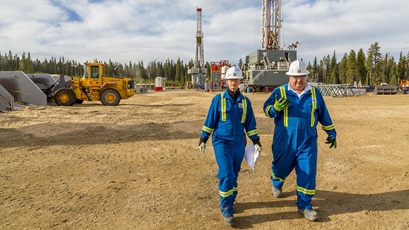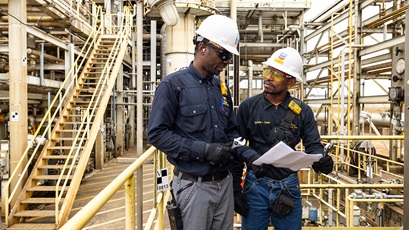our operations
innovation fuels lower carbon, record production
2 min read | february 09, 2024
Chevron’s 2023 U.S. net oil-equivalent production was up 34% year-over-year.
Chevron’s production hit a record 3.1 million barrels of oil-equivalent per day last year, driven by 14% growth in the U.S.
“Last year, we produced more oil and gas than any other year in the company’s history, including a record number of liquefied natural gas cargoes out of Australia,” said Pierre Breber, Chevron’s chief financial officer. “We expect 2024 production to be higher—again—by 4% to 7%.”
In the Permian Basin, an energy-producing powerhouse in West Texas and New Mexico, output was up 10% year-over-year, driven partly by advances in drilling techniques.
The goal is to reach 1 million barrels of oil-equivalent per day in the region by 2025.
why it matters
Energy demand, including for oil and gas, is projected to again reach a record high in 2024.
Doing its part to help meet that growing need, Chevron is expecting to spend approximately $9.3 billion increasing U.S. production.

Chevron set a quarterly record during last year’s fourth quarter, with the Permian Basin reaching 867,000 barrels of oil-equivalent per day.
lower carbon ambitions
The barrels of oil and gas produced in the Permian Basin are nearly one-third the carbon intensity of the global industry average, and Chevron is working to drive the needle down even further.
There’s no lone element to the Permian Basin’s lower carbon progress. Rather, a combination of factors, ranging from takeaway capacity to facility design, help lead to its success.
For starters, it is a mature field with plenty of infrastructure built out to accommodate product takeaway. This helps keep more product in the pipe.
Other ways Chevron is lowering its carbon intensity include:
- Converting traditional, diesel-powered drilling rigs to direct electric or natural gas powered.
- Converting hydraulic fracturing equipment from diesel to dynamic gas blending, which uses a combination of diesel and natural gas.
- Installing electric-powered compressor stations and supplementing grid power with solar fields.

The Anchor facility in the U.S. Gulf of Mexico is expected to produce for the next 30 years at a peak of 75,000 barrels of oil per day.
more on that
Chevron is working to continue increasing its U.S. oil and gas production. This includes:
- Using new drilling and completion technologies in the Permian Basin to boost the amount of oil recovered.
- Continuing production at U.S. Gulf of Mexico facilities, which are some of the lowest carbon intensity producing assets in Chevron’s portfolio.
- Using new technologies that help Chevron access resources that were previously economically challenged.
mike wirth
chairman and CEO
topics covered
related content
-

 explainer: where do oil and gas come from?
explainer: where do oil and gas come from?our operationsdecember 30, 2024
-

 gas development opportunities in sub-saharan Africa
gas development opportunities in sub-saharan Africaour operationsdecember 20, 2024
-

 AI boosts profitability in the permian basin
AI boosts profitability in the permian basinour operationsdecember 18, 2024
-

 new california legislation misleading, chevron exec says
new california legislation misleading, chevron exec saysour operationsnovember 26, 2024
chevron email updates
Subscribe to our newsletter to receive news and updates.



